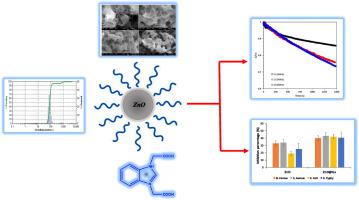Journal of Molecular Liquids ( IF 6 ) Pub Date : 2020-08-21 , DOI: 10.1016/j.molliq.2020.114107 Liliana Margarita García Rojas , Carlos Alberto Huerta-Aguilar , Eduardo Daniel Tecuapa-Flores , Daniela Soledad Huerta-José , Pandiyan Thangarasu , Jagpreet Singh Sidhu , Narinder Singh , Mónica de la Luz Corea Téllez

|
In this paper, benzimidazole based ionic liquid (IL) was prepared, and then coated on ZnO to yield ZnO@IL which was then characterized systematically by different analytical methods such as X-Ray Diffraction (XRD), Scanning Electron Microscopy (SEM), and X-ray Photoelectron Spectroscopy (XPS) before exploring as a photo-catalyst for the oxidation of 4-nitroaniline (4-NA). In XRD, for ZnO@IL, the plane [100] has been shifted to higher angle at 64° in 2θ due to the influence of IL on the ZnO surface. The intensity and shape of the XPS peaks (appearing between 404 and 398 eV) originated from the IL's imidazole nitrogens indicate the existence of a sizable photoemission due to the interaction of NHCs with the electrophilic surface of ZnO. The catalytic oxidation of 4-NA (0.1 M) by ZnO@IL under UV light reveals a considerable degradation, which follows a first order kinetics. The formation of intermediates was analyzed by HPLC-MS, and proposed a possible mechanism for the oxidation. At low pH = 4, a greater oxidation rate (k = 2.01 × 10−4 mM.s−1) was obtained than that observed in higher pH of 10 (k = 0.26 × 10−4 mM.s−1). Additionally, ZnO@IL shows an antibacterial behavior exhibiting a significant microbial inhibition about 45%, and observed a considerable decrease in the cell growth if ZnO@IL presents in the culture medium.
中文翻译:

离子液体涂覆的ZnO纳米复合材料为何作为环境修复剂出现:增强了4-硝基苯胺的光氧化并鼓励了抗菌行为
本文制备了苯并咪唑基离子液体(IL),然后将其涂覆在ZnO上以生成ZnO @ IL,然后通过不同的分析方法,如X射线衍射(XRD),扫描电子显微镜(SEM),和X射线光电子能谱(XPS),然后再作为光催化剂催化4-硝基苯胺(4-NA)的氧化。在XRD中,对于ZnO @ IL,平面[100]已移至2θ中64°的较高角度由于IL对ZnO表面的影响。源于IL的咪唑氮原子的XPS峰的强度和形状(出现在404和398 eV之间)表明由于NHC与ZnO的亲电表面的相互作用,存在相当大的光发射。ZnO @ IL在紫外光下对4-NA(0.1 M)的催化氧化显示出相当大的降解,这遵循一级动力学。用HPLC-MS分析了中间体的形成,并提出了可能的氧化机理。在低pH = 4时,获得的氧化速率(k = 2.01×10 -4 mM.s -1)比在较高pH值为10时(k = 0.26×10 -4 mM.s -1)更高。)。另外,ZnO @ IL显示出约45%的显着微生物抑制作用的抗菌行为,并且如果培养基中存在ZnO @ IL,则观察到细胞生长显着降低。



























 京公网安备 11010802027423号
京公网安备 11010802027423号